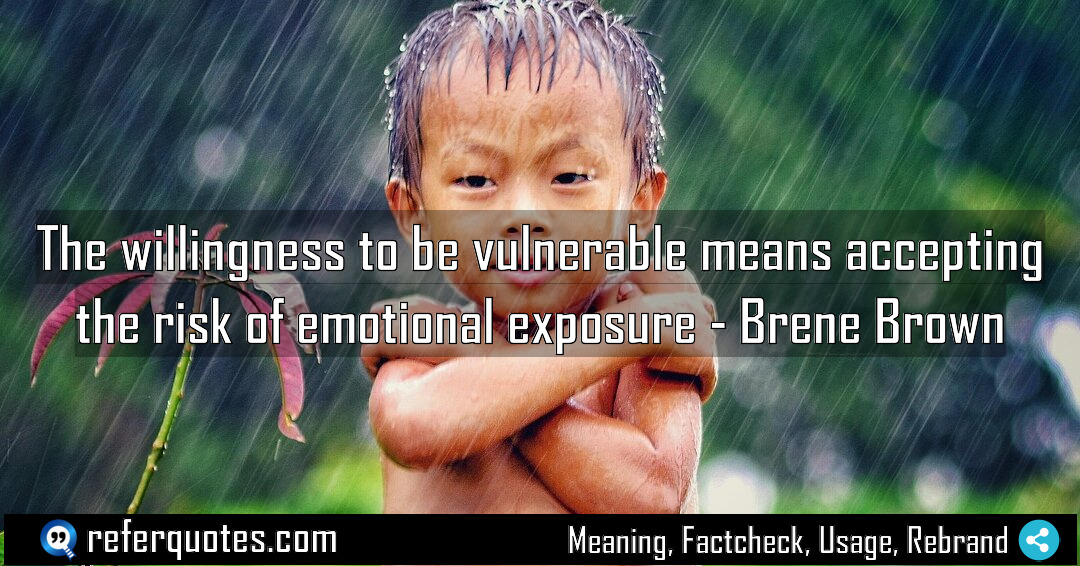
You know, the willingness to be vulnerable isn’t about oversharing. It’s about accepting the risk of emotional exposure, which is the absolute bedrock of any real connection, whether in leadership, love, or life. It’s the courage to show up when you can’t control the outcome.
Share Image Quote:
Table of Contents
Meaning
At its core, this quote means that true connection and courage require you to open yourself up to the possibility of getting hurt. It’s the price of admission for a meaningful life.
Explanation
Let me break this down from my own experience. We often think vulnerability is weakness, right? But Brene flips that entirely. She’s saying that the “willingness,” the active choice, is the strength. “Emotional exposure” is just a fancy term for letting someone see the real, unpolished you—your ideas, your feelings, your “what if I’m not good enough” fears. And “accepting the risk” is the key. You’re not guaranteed a soft landing. The other person might judge you, reject your idea, or not reciprocate. But you do it anyway. That’s the whole game. It’s the fundamental ingredient for trust, innovation, and love. Without it, everything feels… transactional and safe. And safe is where dreams and connections go to die.
Quote Summary
Reading Level40
Aesthetic Score82
Origin & Factcheck
This wisdom comes straight from Brené Brown’s 2012 book, Daring Greatly, which was published in the United States. It’s a cornerstone of her research on shame, courage, and wholehearted living. You sometimes see similar sentiments floating around, but this specific, powerful phrasing is uniquely hers.
Attribution Summary
Author Bio
Dr Brene Brown is the author of books such as Daring Greatly and The Power of Vulnerability. The TED talk and Netflix production based on her research reached out to millions of audience. She researches effects of courage and vulnerability in shaping people's work and relationships. She leads the Brené Brown Education and Research Group and provides evidence-based insights into practical tools to help people train themselves
Official Website |Facebook | X | Instagram | YouTube |
Where is this quotation located?
| Quotation | The willingness to be vulnerable means accepting the risk of emotional exposure |
| Book Details | Publication Year/Date: 2012; ISBN/Unique Identifier: 9781592407330; Last edition. Number of pages: 287. |
| Where is it? | Approximate page from 2012 Gotham edition |
Context
In Daring Greatly, Brown is building her entire case for what it takes to live a “wholehearted” life. This quote sits at the heart of her argument that vulnerability is not a liability but our most accurate measure of courage. She positions it as the essential catalyst—the thing that must happen before trust, innovation, or true belonging can ever occur.
Usage Examples
So how does this play out in the real world? Let me give you a couple of scenarios I’ve seen firsthand.
- For a Team Leader: It’s the manager who says in a meeting, “I don’t have the full answer here, and I need your help to figure this out.” That’s emotional exposure. The risk is looking incompetent. The reward is unlocking the team’s collective intelligence.
- In a Personal Relationship: It’s telling your partner, “When you did that, it really hurt my feelings.” Simple, but so hard. The risk is starting a conflict or being dismissed. The reward is a chance for deeper understanding and intimacy.
- For a Creator or Artist: It’s releasing your work—a painting, a article, a new business idea—into the world. The risk is criticism and rejection. The reward is making a genuine impact and connecting with your audience.
To whom it appeals?
Share This Quote Image & Motivate
Motivation Score86
Popularity Score92
Shareability Score90
FAQ
Question: Is vulnerability the same as oversharing?
Answer: Absolutely not. This is a huge distinction. Vulnerability is about sharing your feelings and experiences with people who have earned the right to hear them, in an appropriate context. Oversharing is often a way to discharge your own discomfort or forge a false sense of intimacy too quickly.
Question: How do I become more vulnerable without getting walked all over?
Answer: Great question. The key is that vulnerability requires boundaries. Brown calls this “having a strong back, soft front.” You need a strong sense of self-worth (the back) to be able to open up authentically (the soft front). It’s not about being a doormat; it’s about being clear and courageous.
Question: Can you be vulnerable at work without damaging your career?
Answer: You can, and in today’s world, it’s often a leadership superpower. It’s not about crying at your desk. It’s about being authentic—admitting mistakes, asking for help, acknowledging your team’s efforts. This builds immense trust, which is the currency of high-performing teams.
Similar Quotes
When we are willing to risk vulnerability, we open ourselves up to more than just potential hurt. It’s the secret, counter-intuitive doorway to the very things we want most: deep…
Staying vulnerable is a risk we have to take if you want to live a wholehearted life. It’s the counterintuitive secret to real connection and courage, not a sign of…
Vulnerability is the birthplace of love… it’s not a weakness, but the very foundation of our most meaningful human experiences. This idea flips everything we’ve been taught about keeping our…
Vulnerability sounds like truth and feels like courage… and honestly, that’s the whole game right there. We’re taught to see vulnerability as a liability, but Brené Brown flips that script…
We can measure how brave you are by how vulnerable… it’s a game-changing way to think about courage. This isn’t about grand, heroic acts, but the quiet strength it takes…
